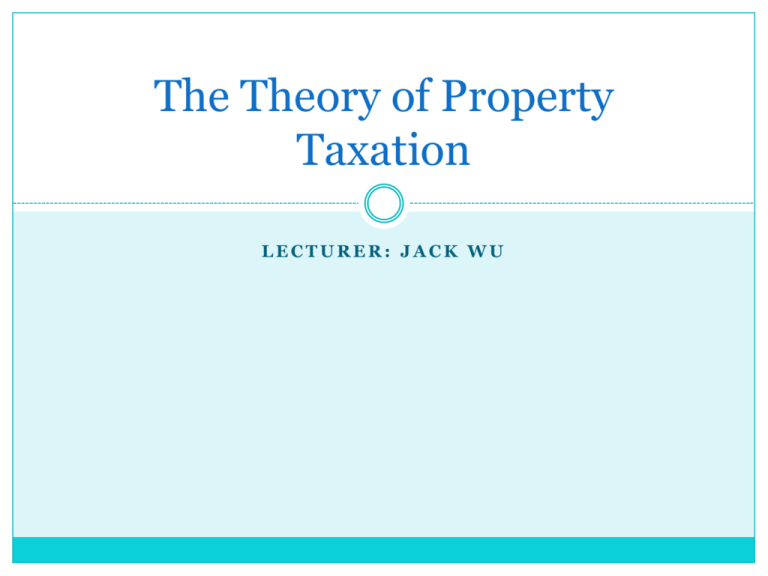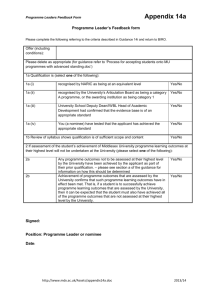Topic 1 What Are Property Taxes
advertisement

The Theory of Property Taxation LECTURER: JACK WU Outline Topic I: What Are Property Taxes? Topic II: Property Tax Incidence Topic III: Property Tax Capitalization Topic IV: Property Tax Competition and Provision of Local Public Goods What are Property Taxes? 1.What are Properties? 2.Defining Property Tax 3.Why levying property tax? 4.Mechanics of Property Taxation 5.The Property Tax Process 6.Economic Issues of Property Tax 1. What are Properties? Property v.s. Wealth Taxonomy of Property Property v.s. Wealth Property: A. something that someone owns B. any tangible or intangible possession owned by someone C. real estate (land or building) that someone owns Wealth: the money value of property Taxonomy of Property Property can be classified as: Personal (Movable) property 動產 v.s. Real property 不動產 Tangible有形 property v.s. Intangible無形 property A Taxonomy of Property 2. Defining Property Tax Narrowly Defined Property Taxes Property Tax in Tax Structure Broadly defined property taxes Property Tax Revenues Narrowly Defined Property Tax Property tax is the tax on the property holding. (note: acquiring, holding, transfer) Property tax is an ad valorem tax that an owner of real estate or other property pays on the value of the thing taxed. (note: it is difficult to levy a tax on personal or movable property) Property Tax in Tax Structure National Tax/ Central Tax Municipal and County Tax/ Local Tax In most countries, property tax is the most important local tax. Taiwan’s Central and Local Taxes Broadly Defined Property Tax According to OECD classification, taxes on property include: 1.Recurrent taxes on immovable property 2.Recurrent taxes on net wealth 3.Estate, Inheritance, and gift taxes 4.Taxes on financial and capital transactions 5.Other non-recurrent taxes on property 6.Other recurrent taxes on property Taiwan’s Property Taxes Narrowly defined property tax Broadly defined property tax Agricultural Farmland Tax 田賦(停 徵) Agricultural Farmland Tax 田賦(停徵) Land Value Tax 地價稅 Land Value Tax 地價稅 House Tax 房屋稅 House Tax 房屋稅 Estate, Inheritance and Gift Tax遺產贈與稅 (中央) Deed Tax 契稅 Security Transaction Tax證券交易稅(中央) Future Transaction Tax 期貨交易稅(中央) Stamp Tax 印花稅 Land Value Incremental Tax土地增值稅 License Use Tax 使用牌照稅 Distribution Ratios of Current Taxes 14 Table: 現行財產稅目及其稅收分配 資料來源:財政部賦稅署。 說明: 1. 根據1999年1月25日增修訂之 財政收支劃分法。 2. 本表所示資料更新截止日為 2009年5月31日。 附註: 1. “A”係指營業稅收入減除依法 提撥之統一發票給獎獎金之 40%。 2. ※ (1) 18%按人口比例分配直 轄市及台灣省各縣(市) 。 (2) 2%按人口比例分配福建省 金門及連江二縣。 3. ◎台北縣徵起之土地增值稅自 2008年1月1日起準用直轄市規 定,即徵起收入100%均歸該 縣所有。 15 Property Tax Revenue 16 Property Tax Revenue/Total Tax Revenue Property Tax Revenue in USA Table 13-1 Property Taxes as a Percentage of General Revenue By Level of Government, Various Years Local Government Year States All Counties Municipalities Townships 65.3 School Districts 51.0 Special Districts 25.0 1962 2.1% 48.0 45.7 44.2 1967 1.7 43.2 42.1 38.1 61.8 46.9 21.5 1972 1.3 39.5 36.5 31.3 64.9 47.3 17.3 1977 1.3 33.7 31.0 25.8 56.8 42.1 14.0 1982 1.1 28.1 26.6 21.4 52.1 35.8 9.5 1987 1.1 28.3 27.1 20.9 52.7 36.4 10.4 1992 1.2 29.9 27.8 23.1 56.0 37.5 10.7 1997 1.3 27.9 24.7 20.7 55.9 36.0 11.9 2002 0.9 27.1 24.2 20.4 55.8 34.2 11.0 Sources: U.S. Department of Commerce, Compendium of Government Finance, and Bureau of the Census, Governmental Finances, various years. 19 Table 13-2 Property Taxes as a Percentage of Taxes By Level of Government, Various Years Local Government Year States All Counties Municipalities Townships 93.3 School Districts 98.6 Special Districts 100.0 1962 3.1% 87.7 93.5 93.5 1967 2.7 88.6 92.1 70.0 92.8 98.4 100.0 1972 2.1 83.7 85.6 64.3 93.5 98.1 94.9 1977 2.2 80.5 81.2 60.0 91.7 97.5 91.2 1982 1.9 76.1 77.2 52.6 93.7 96.8 79.6 1987 1.9 73.6 73.5 49.1 92.3 97.5 70.3 1992 2.2 75.6 74.4 52.9 93.0 97.4 66.8 1997 2.3 73.3 69.4 48.7 92.4 96.9 76.5 2002 1.8 72.9 69.1 48.6 91.6 96.2 69.8 Sources: U.S. Department of Commerce, Compendium of Government Finance, and Bureau of the Census, Governmental Finances, various years. 20 3.Why Levying Property Tax? Canons of Taxation Virtues of property tax Canons of Taxation Simple Equitable (horizontal, vertical, inter-generational, and process equity) Stable Non- or least distortion Low administration and compliance costs Virtues of Property Tax An old tax A stable tax An easy-to-administer tax A benefit tax A tax that allows local control A visible tax An Old Tax An old tax is a good tax. Principle of good tax policy: a tax system should change infrequently. A Stable Tax Stability and reliability are considered two requirements for creating a sound tax system. Few taxes are more reliable than those on real property. Unlike other local taxes, the property tax base cannot be moved. The revenue from such a captive tax base can be relied on to a greater extent than either wage or sales taxes – both of which have highly mobile tax bases. The steady growth of property tax revenue (real property values appreciate over time) can meet future public service needs. An Easy-To-Administer Tax The governments’ administration of property tax and taxpayers’ compliance with the property tax are relatively straightforward and inexpensive. The tax is easy to administer because the underlying tax base is immobile and easily identifiable. Moreover, taxpayers cannot easily hide or move property. Thus, the property tax is hard for property owners to evade. Most taxpayers (property owners) face minimal compliance cost because they do not need to fill out any property tax form. A Benefit Tax Property tax revenue is raised locally to support local public services. Thus, the connection between the source of revenue (property) and what is being provided (public services) has stayed strong. The local public services provided benefit the owners of property within the jurisdiction. The beneficiary of the public services is the property owner, and under the benefit principle of taxation, it is the property owner who should be paying for the services. Many economists have recognized property tax is a benefit tax. A Tax that Allows Local Control The property tax is the best available independent source of local revenue. The property tax has given local constituencies control over their financial matters. Local fiscal autonomy is a direct result of reliance on property taxes. Central government does not levy tax on real property. Thus, theoretically, local governments should have greater flexibility with the property tax system than with other major taxes. A Visible Tax Taxpayers know the amount , the frequency, and the purpose of the property tax. Unlike sales taxes (which are paid to vendors) or income taxes (which are generally withheld by employers), property taxes are generally paid to the government. 4.Mechanics of Property Taxation Major issues of Property Tax Property Tax Base Valuation Methods Property Tax Rates Property Tax Relief Measures Major issues Tax base issue: How is the tax base defined and measured? Tax rate issue: What political groups have responsibility for setting tax rates and how those rates are measured? Economic effect issue: What policies are used to reduce overall property taxes or to alter the distribution of tax among different types of properties and taxpayers? Property Tax Base Market value of property The tax base of property tax is the market value of property Assessment value of property: Not all of properties are not transacted in the market in the given year, so it is necessary to assess the value of property annually by tax assessors. Valuation Methods Market Value approach 市場價值比較法 Income capitalization approach 所得還原法 Replacement cost approach重置成本法 Market Value Approach Use the observed market prices for properties to estimate value for a subject property. Suppose that we want to value a three bedroom, two bath home in the Dogwood Subdivision. We could analyze the sales prices for all such comparable homes over the past year to value the subject property. Income Capitalization Approach For income producing properties, we can estimate value by computing the discounted present value of the net income stream generated by the properties. We need information on net income to do this. Replacement Cost Approach To estimate the value of property by computing the replacement cost and subtracting depreciation. This is the only alternative for unique properties, or properties for which an active market has not developed, or for which no net income data is available. Three approaches to value In theory, all three approaches to value should lead to the same conclusion, or very nearly the same conclusion. In practice, they differ and it is important for the assessor to understand the strengths and weaknesses of each approach. Summary In most instances, the market value approach is used to assess single-family homes and land for which there are often numerous sales, while the replacement cost and income capitalization approaches are usually used for commercial and industrial properties. Assessment Ratio Rule An assessor computes the assessed value of each piece of property from an estimate of the property’s market value according to a specific set of procedures , usually established by law. Given that estimate of market value, the assessed value is specified by law or common practice as some specific percentage of market value, called the assessment ratio rule, or at least must be within some specified range of percentage of market value. Classified Property Taxes If different types or classes of property are assessed according to different assessment ratio rules, the tax is called classified property tax. Residential property are usually assessed at a lower ratio than commercial and industrial property. In addition, some types of property may be exempt from property tax. The assessed value of these properties is set equal to zero. Property Tax Rates How to set the tax rate? Property tax rate and Local Public Services Nominal tax rate and effective tax rate How to set the tax rate? Property tax revenue= tax rate*Tax base Given the total assessed value of all properties in a taxing jurisdiction, the local government sets a tax rate sufficient to generate the desired property tax revenue. Central laws constrain the local government in setting the property tax rate by limiting the tax rate, property tax revenue, or both. Property Tax Rate and Local Public Services • • Many local governments rely on the Property Tax to fund local public services. Hence, the Property Tax rate is actually a combination of many rates. Each local government unit sets its own rate, taking into account desired public service levels and the tax base. A combination of rates Nominal Property Tax Rates The nominal tax rate is t = T/Va T the tax paid Va the assessed value The assessed value Va is a fraction of the market value. Let a the assessment ratio, Va = aV a = Va/V. Nominal Tax Rate of Land Value Tax in Taiwan Range of Land Value Land Value < Starting Threshold (ST) Marginal Tax Rate 1% ST< Land Value < 5*ST 1.5% 5*ST< Land Value < 10*ST 2.5% 10*ST< Land Value < 15*ST 3.5% 15*ST< Land Value < 20*ST 4.5% 20*ST < Land Value 5.5% Nominal Tax Rate of House Tax in Taiwan Classification Max. Rates Min. Rates Actual Rates Enforced by the majority of counties (cities) Residential Houses 2.0% 1.2% 1.2% Business Houses 5.0% 3.0% 3.0% Houses for other purposes* 2.5% 1.5% 2.0% Effective Tax Rate The effective tax rate, the ratio of tax to market value, is a usual way to characterize property tax levels on different properties or in different jurisdictions. Because tax is compared to market value, the effective tax rate corrects for any difference in assessment ratios. Effective Property Tax Rate The effective tax rate is the ratio of the tax paid to the market value of the property: t = T/V. Substitution for V gives the relationship t = at. Hence, the effective tax rate is a combination of the nominal tax rate and the assessment ratio. Evidence from USA Residential Property Tax Rates in Selected Cities (1998) Nominal tax rate Assessment Ratio Effective tax rate (%) (%) (%) City Milwaukee, Wis. 3.03 99.1 3.00 Detroit, Mich. 5.76 40.7 2.34 Fargo, N. Dak. 47.99 4.2 2.02 Coulumbia, S.C. 36.25 4.0 1.45 Chicago, Ill. 8.84 16.0 1.41 Washington, D.C. 0.96 97.0 0.93 Source: Government of Dthe District of Columbia, Tax Rate and Tax Burden: A Nationwide Comparison, 1998, Table 4, p.19. More Evidence from USA Residential Property Tax Rates in Selected Cities (1995) City Bridgeport, CT Newark, NJ Milwaukee, WI Des Moines, IA Houston,TX Philadelphia, PA Jaksonville, FL Phoenix, AZ Portland, OR Chicago, IL Memphis, TN Boston, MA Minneapolis, MN New York City, NY Los Angeles, CA Effective tax rate (%) 4.75 3.68 3.58 2.98 2.67 2.64 2.20 1.82 1.80 1.79 1.53 1.39 1.34 0.86 0.74 Source: Statistical Abstract of the United States 1997 , Table 497. Evidence from EU Country Tax Base Austria Germany Assessed standard value Taxable value Notional rental value Taxable value Greece Assessed value Italy Imputed rental income Public valuation Valuation code Cadastral value Finland France Netherlands Portugal Spain Nominal Tax Rate Estimated Effective Tax Rate Basic Federal rate of 0.5% 0.2% 0.22%~0.5% 0.36% Certain coefficients 0.5% to half 0.35% federal rate 1.5% on average Municipal (0.98%~2.1%) coefficient:2.8~6 Progressive rate 0.57% 0.3%~0.8% (State) 0.025%~0.035%(loc al) 0.4%~0.7% 0.5% 0.1%~0.9% 0.7%~1.3% 0.4% urban, 0.3% rural 0.5% 1% 0.4% Evidence from Taiwan 台灣地區地價稅有效稅率( 1997) 課稅土地 公告地價 推估市價 地價稅收 估價比率 土地面積 總額 總額 縣市 (公頃) (億元) (億元) (億元) % A B C T B/C 4,386 15,583 48,758 137 32.0 台北市 6,263 4,392 18,654 43 23.5 高雄市 14,437 6,929 40,556 70 17.1 台北縣 3,303 445 4,122 4 10.8 宜蘭縣 13,150 2,893 23,312 33 12.4 桃園縣 5,168 660 4,462 7 14.8 新竹縣 5,567 574 4,858 6 11.8 苗栗縣 9,027 1,596 14,012 16 11.4 台中縣 8,299 1,172 15,492 12 7.6 彰化縣 3,429 495 5,343 5 9.3 南投縣 4,424 752 4,706 7 16.0 雲林縣 4,181 414 3,430 4 12.1 嘉義縣 8,941 1,048 8,331 10 12.6 台南縣 8,761 1,539 10,406 16 14.8 高雄縣 5,450 739 7,306 8 10.1 屏東縣 1,757 120 1,120 1 10.7 台東縣 2,959 314 3,185 3 9.9 花蓮縣 779 65 721 1 9.0 澎湖縣 2,626 627 4,167 7 15.0 基隆市 1,736 980 3,922 10 25.0 新竹市 4,056 1,572 8,076 17 19.5 台中市 1,286 717 5,407 6 13.3 嘉義市 3,190 1,768 8,421 19 21.0 台南市 123,175 45,394 248,767 442 18.2 合 計 資料來源:華昌宜(1999),「土地持有課稅之研究」,表45。 平均有效 稅率 % T/C 0.28 0.23 0.17 0.10 0.14 0.16 0.12 0.11 0.08 0.09 0.15 0.12 0.12 0.15 0.11 0.09 0.09 0.14 0.17 0.25 0.21 0.11 0.23 0.18 Taipei’s Effective Tax Rates I District Mean tax rate Median tax rate Standard deviation Datong Wanhua Zhongzheng Zhongshan Daan Xinyi Songshan Nangang Neihu Shilin Beitou Weshan Whole Taipei 0.1142% 0.1105% 0.0930% 0.1105% 0.0911% 0.0867% 0.0924% 0.1069% 0.0836% 0.0779% 0.0828% 0.0860% 0.0912% 0.1026% 0.1074% 0.0844% 0.1040% 0.0824% 0.0789% 0.0821% 0.0895% 0.0805% 0.0726% 0.0774% 0.0804% 0.0829% 0.0444% 0.0367% 0.0471% 0.0419% 0.0382% 0.0331% 0.0412% 0.0471% 0.0246% 0.0281% 0.0280% 0.0282% 0.0364% Taipei’s Effective Tax Rates II Zone Old West New West Central East North South Transaction Year 2002 2003 2004 2005 2006 House Type Tall building Low apartment Single house Mean tax rate 0.1118% 0.1059% 0.0901% 0.0887% 0.0802% 0.0860% Median tax rate 0.1050% 0.0979% 0.0813% 0.0818% 0.0743% 0.0804% Standard deviation 0.0397% 0.0439% 0.0377% 0.0324% 0.0282% 0.0282% 0.1099% 0.1140% 0.0904% 0.0828% 0.0781% 0.1003% 0.1018% 0.0818% 0.0760% 0.0712% 0.0377% 0.0446% 0.0353% 0.0302% 0.0286% 0.1099% 0.0737% 0.0661% 0.1023% 0.0702% 0.0654% 0.0389% 0.0222% 0.0217% Equalized Tax Rate the equalized property tax rate can be measured based on either of the following two ratio definitions: the ratio of assessment value to market sale value and the ratio of assessment value to taxable value. 公告地價佔市價百分比 年期 台北市 連江縣 高雄市 嘉義市 台南市 雲林縣 新竹市 基隆市 台北縣 新竹縣 屏東縣 嘉義縣 桃園縣 高雄縣 台南縣 彰化縣 台中市 苗栗縣 花蓮縣 台東縣 南投縣 台中縣 澎湖縣 宜蘭縣 金門縣 總計 2000 29.6 17.9 20 19 18.75 14.12 17.96 16.85 19.8 15.34 14.3 15 12.16 12.55 15.1 11.18 11.5 15.1 7.37 11.54 11.62 11.9 5.97 9 4.41 資料來源:內政部, 2007.1.10修正 57 2004 34.4 25.6 28 24 26.25 20.8 23.8 19.38 20.9 16.86 19.52 17.45 16.61 15.35 14.52 12.97 15.6 14.82 15.3 12.98 12.95 13.21 11 12 6.56 17.35 2007 34.48 30.89 29.51 26.42 24.83 24.58 24.25 23.95 21.75 20.82 20.60 20.00 18.72 18.43 17.11 16.91 16.88 16.72 15.24 14.70 14.18 13.28 10.79 10.61 8.11 19.04 Taipei’s equalized tax rate equalization rate Max Min Average Median Standard Deviation Shilin 0.959163 0.072766 0.227145 0.208128 0.094281159 Datong 0.982054 0.085654 0.285919 0.261333 0.123517493 Daan 0.865928 0.078071 0.245173 0.224139 0.097422656 Zhongshan 0.945537 0.06431 0.266169 0.247347 0.104440393 Zhongcheng 0.93837 0.115859 0.268209 0.241919 0.117056327 0.640307 0.071391 0.205071 0.195097 0.061785022 0.91505 0.030581 0.225689 0.21134 0.075738607 Beitou 0.655623 0.028608 0.22725 0.209418 0.08756853 Songshan 0.587363 0.022534 0.238232 0.223447 0.080671151 Xinyi 0.809658 0.062274 0.25648 0.236767 0.103844435 Nangong 0.536957 0.108182 0.211149 0.195289 0.069300413 Wanhua 0.985836 0.017567 0.292225 0.273433 0.1138614 Neihu Wenshan 2002 0.9858 0.0623 0.2777 0.2590 0.1039 2003 0.9592 0.0706 0.2827 0.2587 0.1087 2004 0.9821 0.0378 0.2371 0.2171 0.0912 2005 0.8878 0.0225 0.2250 0.2082 0.0838 2006 0.9455 0.0176 0.2091 0.1933 0.0785 Tall building 0.9455 0.0643 0.2198 0.2037 0.0791 Low apartment 0.9858 0.0225 0.2560 0.2360 0.1025 Single house 0.6554 0.0176 0.2875 0.2763 0.1156 Property Tax Relief Measures Local government uses a variety of measures to reduce property taxes for specific classes of property or specific types of taxpayers. These measures include: Limits on assessed value Exemptions of assessed value for homesteads state government credits or rebates for local residential property taxes Individual income tax deduction for property taxes Special assessment methods for farmland 5. Property Tax Process Rule Tax variable Agent Actual or true market Value of property Assessment ration rule Exempt property Assessor Assessed or taxable Value of property Ruling elected body Of taxing government Actual or true market Value of property Referendum (required or optional) Property tax levy Tax collector Property tax revenue Fisher (2007, 3e), Figure 13.1, p. 321. Source: Florida Department of Revenue. http://dor.myflorida.com/dor/property/infographic07.pdf 61 62 63 64 65 Source: Michigan Department of Treasury, http://www.michigan.gov/documents/868f_2682_7.pdf Fisher (2007, 3e), Figure 13.2, p. 325. 66 67 Source: The County of Isabella, http://www.isabellacounty.org/news/hearing061907.pdf 68 69 70 71 72 73 6: Economic Issues of Property Tax System The Property tax system for the nation as a whole depresses the return on capital and changes the cost of capital to higher-tax communities and decreases the cost of capital to low-tax communities. Issues Efficiency Issue The effects of the Property Tax on the amount, type, and location of property. Equity Issue The effect of the Property Tax on the distribution of the tax burden. Policy Implications The design of the tax system Proposals of tax reform The Extent of Property Tax Capitalization The Property Tax Competition







